Last-Minute NYC Holiday Gift Guide 🎁
We’ve created a holiday gift guide with presents for the intrepid New Yorker that should arrive just in time—


hough the skyscrapers, crowded streets, and lack of sandy beaches make it is easy to forget that Manhattan is in fact an island, its position at one of the best harbors in the world has influenced life on land for centuries. From the days of the Native Americans, through colonial times, and up to the present day, New York City’s waterways have played a major role in business, war, and society. There have been countless triumphs and tragedies that have taken place on the seas, rivers and bays that surround and run through the city. Here are 10 monuments and memorials dedicated to significant people and events connected to New York City’s maritime history:
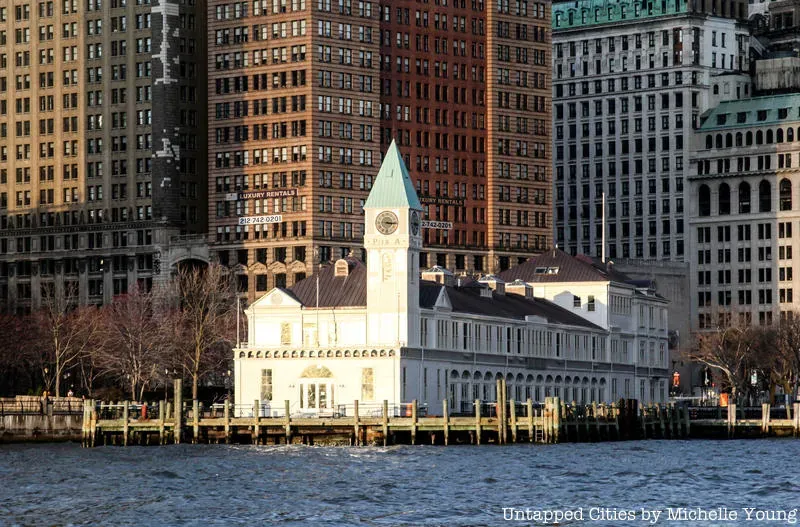
Most recently, a restaurant and bar (which shuttered and has yet to reopen since 2020), the Pier A Harbor House, was originally constructed from 1884 to 1886 to serve the New York City Department of Docks and Harbor Police. The clocktower which rises from the waterfront side of the building was not part of the original structure. It was added in 1919 as a memorial to the 116,000 U.S. servicemen who died during World War I. It is the first World War I memorial erected in the United States. The clock was donated by Daniel G. Reid, founder of United States Steel Corporation and was unveiled at noon on January 25, 1919 by Rear Admiral Josiah S. McKean, with speeches made by Mayor John Francis Hylan and Docks Commissioner George Murray Hulbert.
The clocktower is unique because it does not chime like you would expect it to. The clock is one of only two in the entire country set to ship’s bell time. Ship’s bell time is an old maritime way of telling time based on the port and starboard watch shifts of a ship’s crew. Each crew member would be on duty for four hours, then off four hours. One stroke of the ship’s bell indicated the first half hour of the watch. Then an additional bell is struck for each succeeding half hour. Thus eight bells indicate the end of a four-hour watch.
From 1960 until 1992, The New York City Fire Department used the pier as a fireboat station, and then the building fell into neglect for almost a decade. In 2009 it was restored and turned into the business that it is today.
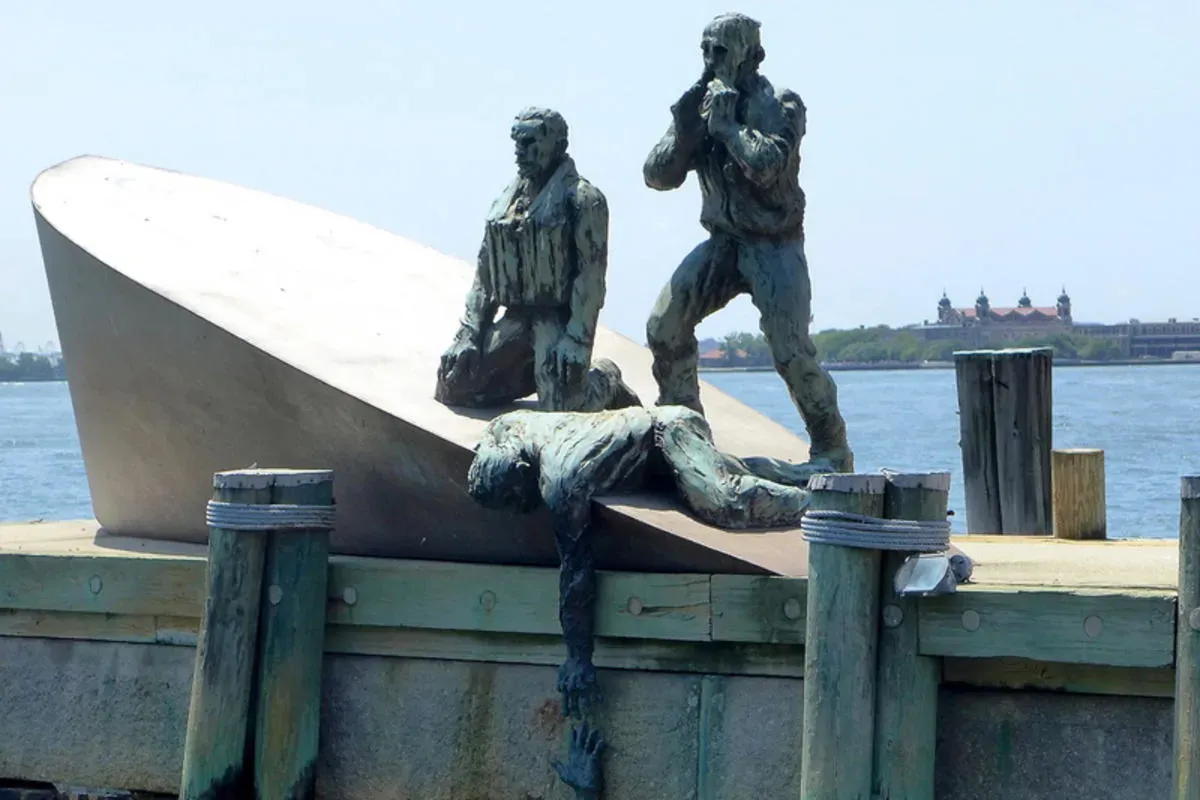
Perhaps one of the most haunting statues in the city, thanks to its tragic subjects and the natural bronze oxidation which exacerbates their looks of dread, the American Merchant Mariner’s Memorial honors the thousands of merchant mariners who have died at sea in the course of our nation’s history. The memorial was commissioned in 1976 by the American Merchant Mariners’ Memorial, Inc. and it took more than ten years for the organization to choose an artist to create the memorial. The artist eventually granted the commission in 1988 was Paris born, Venezuelan raised, New York artist Marisol Escobar.
Escobar’s memorial stands just off Pier A on a rebuilt stone breakwater in the harbor. The bronze sculpture is based on a photograph from a tragic attack during World War II. The photograph was taken by the captain of a German ship as American merchants clung to their sinking vessel, the SS Muskogee, after it was attacked by Nazi U-boats in 1942. The fate of the Muskogee was not known for many years and the photograph became the subject of an Unsolved Mysteries episode.
It is estimated that 700 American merchant ships were lost during the conflict and mariners suffered more casualties than any other American service. What makes the memorial even more poignant is the fact that the bottom figure reaching up from the water gets covered by the high tide of Upper New York Bay twice a day, as his finger tips still stretch just above the waterline.
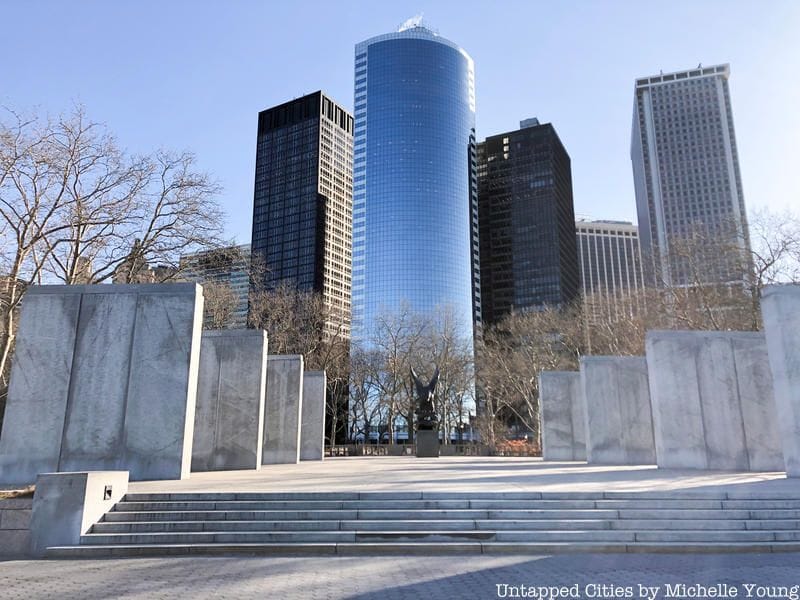
Located at the southern end of Battery Park, the East Coast Memorial is hard to miss. The Gehron and Seltzer designed memorial, which features eight towering 19-foot tall granite pylons and a soaring bronze eagle, honors the 4,601 missing American servicemen who lost their lives in the Atlantic Ocean while engaged in combat during World War II. The monument was commissioned by the American Battle Monuments Commission (ABMC) and dedicated by President John F. Kennedy on May 23, 1963.
The walls are inscribed with the names, rank, organization and state of each of the deceased. The eagle, which faces the Statue of Liberty, was sculpted by Albino Manca and set on a pedestal of polished black granite. He grips a laurel wreath over a wave which signifies the act of mourning at a watery grave.
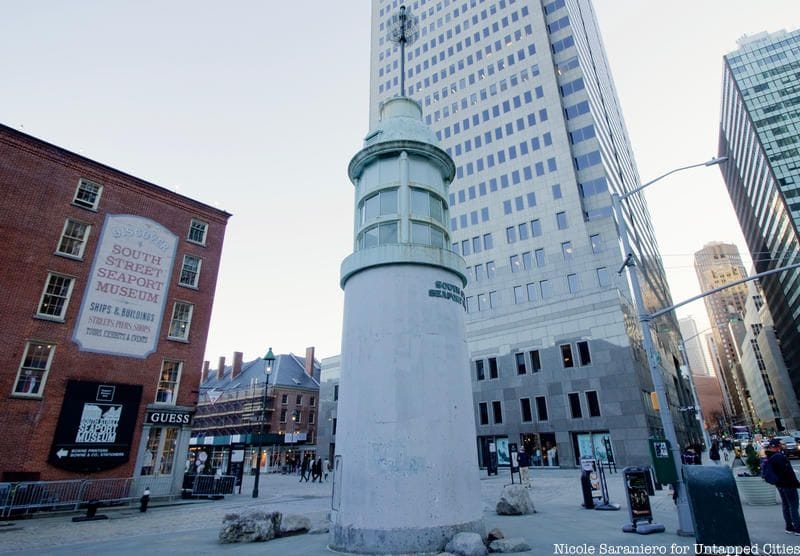
New York City was the destination of the Titanic’s ill-fated voyage in 1912, and though most of the ship’s passengers never made it to New York’s shores, hundreds of survivors did. There are connections to the Titanic spread throughout Manhattan, from the former offices of the White Star Line and the Jane Hotel where surviving crew members were housed, to the South Street Seaport where you will find one of New York City’s memorials to the victims of the ship’s sinking.
The 60-foot tall Titanic Memorial Lighthouse and Time Ball was dedicated one year after the sinking of the Titanic, on April 15, 1913. It was originally mounted on top of the Seamen’s Church Institute at 25 Water Street. A time ball is an obsolete time signaling device that is dropped at a predetermined time, principally to enable navigators aboard ships offshore to verify the setting of their marine chronometers. Everyday at noon from its installation in 1913 until 1967, the Titanic time ball received a telegraphic signal from the Naval Observatory in Washington D.C and dropped halfway down the pole to indicate that the time was 12pm.
In July 1968 the Seamen’s Church Institute moved to 15 State Street and the Titanic Memorial Lighthouse was donated by the Kaiser-Nelson Steel & Salvage Corporation to the South Street Seaport Museum. It was erected at the entrance to the museum complex, on the corner of Fulton and Pearl Streets, in May 1976, with funds provided by the Exxon Corporation.

The Immigrants sculpture in The Battery honors the memory and struggle of the almost 14 million immigrants who traversed oceans in search of a better life in New York City. The sculpture by Luis Sanguino stands at the south end of the Eisenhower Mall in The Battery near Castle Clinton. In addition to the more well known Ellis Island Immigration Center, Castle Clinton also served as a processing facility for newly arrived immigrants from 1855 to 1890, while the center at Ellis Island was being built.
The memorial depicts a diverse group of immigrants from an Eastern European Jew, to a freed African slave, a priest, and a worker. It is crafted out of bronze and stands atop a base of Minnesota Rideau Red granite. The statue was originally dedicated in May of 1983.
Learn more about the immigrant history of New York City Behind-the-Scenes Hard Hat tour of Ellis Island’s Abandoned Hospital Complex.
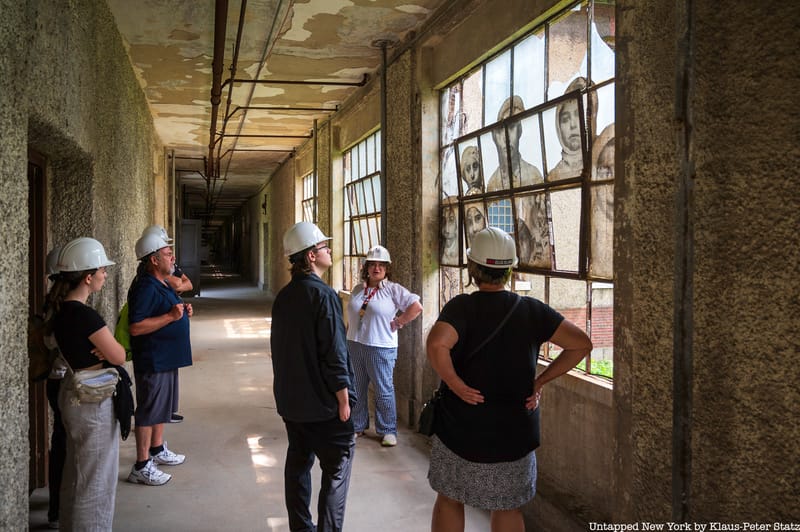
Gain access to spaces usually off-limits to the public!

Also on the long list of Battery monuments is one dedicated to the Italian explorer and navigator Giovanni da Verrazzano. In 1524, Verrazano became the first European known to have entered New York Bay on his journey along the eastern seaboard of the United States and Canada. Amid 300th anniversary celebrations in 1909 of Henry Hudson’s voyage up his eponymous river, Italian-Americans felt that Verrazano was not getting his due. Carlo Barsotti, the editor of Italian language newspaper Il Progresso, launched a subscription campaign to raise money for a sculpture to Verrazzano. Italian sculptor Ettore Ximenes agreed to donate his time.
The statue was unveiled on October 6, 1909 at the tip of Battery Park, in what is now known as the Battery Lawn. There was also a time capsule buried underneath the statue which contained coins from four countries, bronze medallions, and documents. The statue is made up of a 5-foot tall bronze bust of the explorer set atop an elaborate granite pedestal with side volutes and a bronze female allegorical figure representing discovery. An inscription on the east side of the pedestal reads: “For the sake of historical truth and justice, this monument was erected by Il Progresso Italo-Americano, edited by Carlo Barsotti, with the support of the Italians resident in New York, 6 October 1909.” Other inscriptions tell of Verrazzano’s exploratory achievements.
In the early 1940s, Verrazzano was removed to make way for construction of the Brooklyn-Battery Tunnel. In 1949, Italian immigrant John N. LaCorte founded the Italian Historical Society of America to improve the image of Italian-Americans and made the restoration and reinstallation of the Verrazano sculpture one of his main goals. By the 1950s, the statue was fixed up and re-erected near the center of the park.

Located just a short walk from the Verrazzano sculpture, a little further down Battery Place, stands the Walloon Settlers Memorial. The nearly 10-foot monument made of Hainaut granite, a Belgian stone, was designed by famous architect Henry Bacon, who also designed the Lincoln Memorial in Washington, D.C.. The gilded inscription recognizes the Walloon Settlers, a group of Belgian Huguenot families who travelled to America with the Dutch in 1624.
The Walloons were among the first settlers to make the trek across the Atlantic Ocean from Europe to the New World. They joined Dutch settlers sailing out on the ship Nieu Nederland, or New Netherland. The Walloons were natives of Belgium who fled to Holland to escape religious persecution. Originally the group, led by Jesse de Forest, planned to settle in a British-controlled colony in Virginia, but the British denied their request. Their petition to the Dutch West India Company was accepted and they travelled with the Dutch to New Amsterdam instead.
Learn more about Manhattan’s history as Dutch New Amsterdam and see how the colony influenced the city we know today on our Remnants of Dutch New Amsterdam Tour!
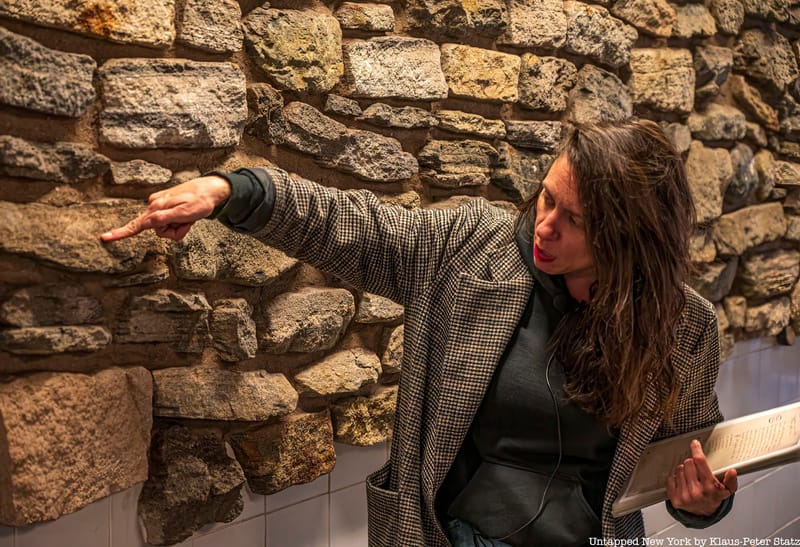
Saturday, May 24th at 2pm ET: Learn more about NYC's Dutch history as you trace the original street grid and physically touch remnants like an 18th-century wall and the Bowling Green Fence!
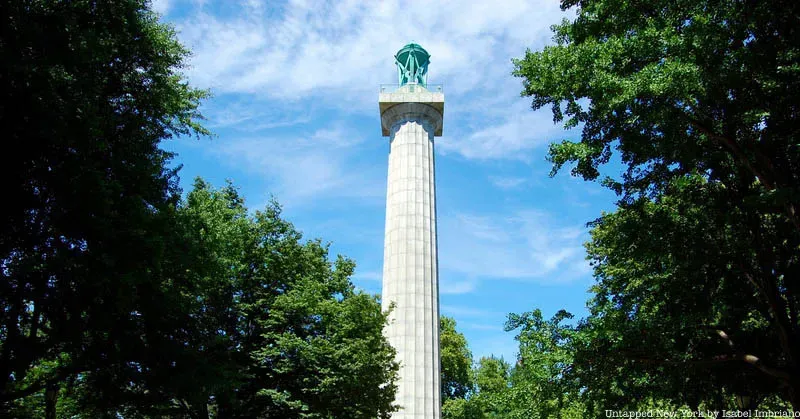
Standing 149 feet tall in front of a grand 100-step granite staircase, the Prison Ship Martyrs Monument in Fort Greene Park marks the burial site of the remains of thousands of American prisoners of the Revolutionary War. After winning the Battle of Long Island and control of Fort Putnam, later rebuilt and renamed Fort Greene during the War of 1812, the British detained thousands of American men and women on prison ships anchored in Wallabout Bay. On the ships, the prisoners experienced overcrowding, contaminated water, starvation and disease. The bodies of those who died were haphazardly buried along the shore.
The impressive over 100-year old monument to those victims was designed by the renowned architectural firm of McKim, Mead and White in 1905. The towering Doric column and surrounding staircase and plaza atop the hill were dedicated in 1908 at a ceremony attended by President elect William Howard Taft. The bronze pieces of the monument, which include the large urn on top, were designed by Sculptor Adolph Alexander Weinman. The monument was once adorned with four bronze eagles as well, but they were removed to storage in the 1960s after being repeatedly vandalized. In 2008, 100 years after the original dedication, two of the bronze eagles were restored and reinstalled along with two replicas.
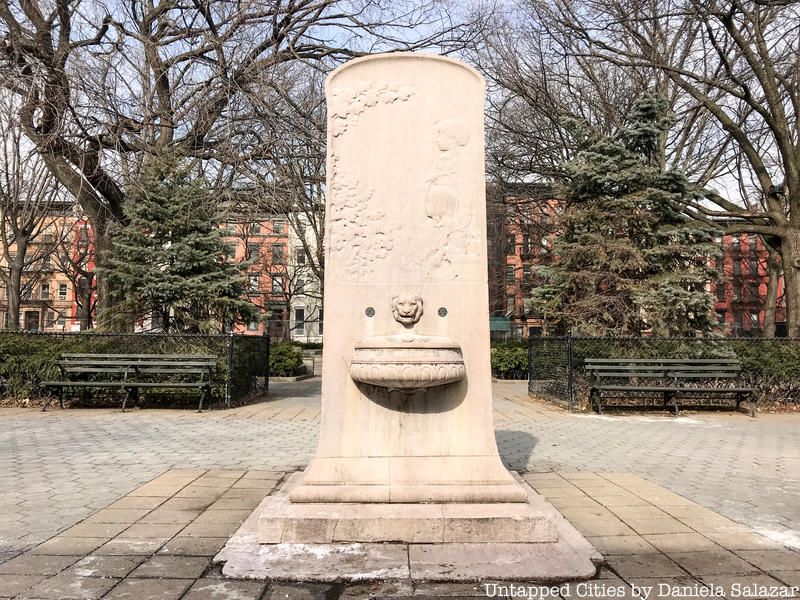
Tompkins Square Park in Manhattan’s East Village is where you will find a memorial dedicated to a tragedy with the highest death toll in New York City history until the September 11th attacks, and to this day, the worst inland-water, peacetime tragedy in U.S. history.
The Slocum Memorial Fountain, located in the north side of the park, pays tribute to the General Slocum passenger steamboat disaster that took place on June 15, 1904. The Slocum was a triple-decker wooden ship built in 1891 and it served as an excursion steamer. Excursion steamers were a popular way for working class New Yorkers to escape the city for a little while. The Slocum’s usual route was to Rockaways, but for its final voyage it was to take a large party to Locust Grove on Long Island. The ship actually caught fire at the treacherous junction of the East River, New York Harbor and the Long Island Sound. Many blamed the incident on inadequate safety precautions and the negligence of the Captain.
Since it was a weekday, the majority of the disaster’s over 1,000 victims were German immigrant mothers and children. Bruno Louis Zimm designed the memorial which is made of pink Tennesee marble with a relief sculpture of two children and flowers. The spout of the fountain is a lion’s head. The inscription on the side reads:
IN MEMORY OF THOSE WHO LOST THEIR LIVES IN THE DISASTER TO THE STEAMER GENERAL SLOCVM JVNE XV MCMIV”

The iconic gilded monument that towers over the Merchants’ Gate entrance to Central Park on West 59th Street at Columbus Circle, was originally intended for the mouth of New York Harbor.The colossal monument is dedicated to the nearly 260 American sailors who died in the explosion of the U.S.S. Maine in 1898 in Havana, Cuba. The creation of a public monument to the victims of the Maine explosion was thanks to donations sent in to the New York Morning Journal at the behest of publisher William Randolph Hearst. Since it was dedicated to a tragedy at sea, Hearst felt, “A monument standing at the mouth of the Narrows, looking out over the ocean, would form a memorial worthy of the brave fellows who died while on duty for their country.”
The monument didn’t end up at the harbor and Central Park was not even the second choice location. After the harbor, the plan was to install it at what was then called Longacre Square, now Times Square, at the present location of the midtown TKTS booth. However, the designated spot for the monument already had a comfort station built on it, a detail over looked due to a “clerical error.” Finally, the architects, H. Van Buren Magonigle and Attilio Piccirilli settled on Merchant’s Gate where it was dedicated in 1913.
Measuring in at sixty-three feet high, the monument is one of the tallest in the city. Piccirilli created the giant gilded, bronze sculptures that top the marble pylon, as well as the marble figures that surround the base. Piccirilli and his five brothers operated a studio in the Mott Haven section of the Bronx where they created other iconic sculptures such as the lions in front of the New York Public Library (who are named Patience and Fortitude) and portions of the Washington Square Arch in Greenwich Village. The sculptures are rife with symbolism, and nautical imagery can be found all over the monument, from dolphins and seashells to a ship’s prow and seahorses.
Next, check out 8 NYC Monuments Dedicated to Real Women and 6 Famous Shipwrecks in NYC
Subscribe to our newsletter